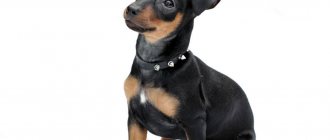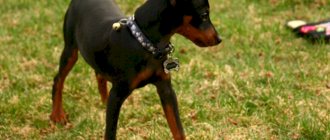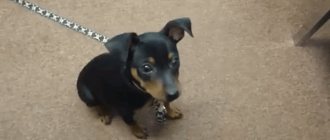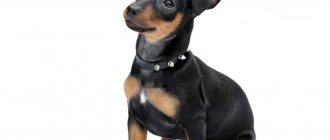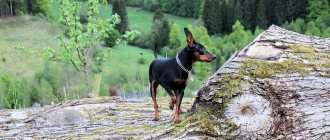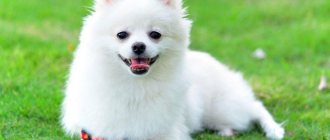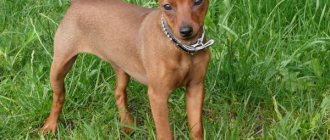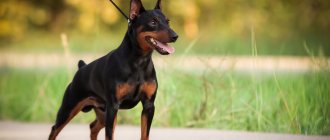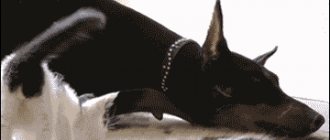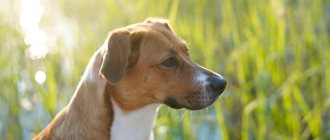Charming miniatures are the smallest representatives of pinschers, who have won love in all corners of the world. Initially, these dogs were used as skilled rat catchers in stables, and only by the 20th century were they made companion dogs.
Before purchasing a pet, it is important to familiarize yourself with the key features of miniature pinschers, existing varieties of the breed, rules of care and maintenance.
Breed characteristics
| Short description | |
| Origin: | Germany |
| Conditions of detention: | In the apartment |
| Purpose: | Companions, guards |
| Color: | Black and tan, red |
| Wool length: | Average |
| Adult dog size: | The height of males is 25–30 cm, the height of females is 24–29 cm, the weight of males is up to 5 kg, the weight of females is up to 4 kg |
| Average life expectancy: | 15 years |
| Walk: | Twice a day, at least 45 minutes |
| Physical activity needs: | Average physical activity needs (walking 1 to 3 hours per day) |
| Fédération Cynologique Internationale (FIC) classification: | Group 2: Pinscher and Schnauzer, Molosser, Mountain and Swiss Cattle Dogs; Section 1: Pinschers and Schnauzers |
| Puppy price: | Show class – 25 – 30 thousand rubles, breeding class – 15 – 20 thousand rubles, pet class – 10 – 15 thousand rubles, without class up to 10 thousand rubles |
Appearance: size, height, weight, structure of the muzzle, ears
Since childhood, a miniature puppy has a harmonious physique - this is something many dwarf breeds lack. The average height is 23-25 cm, although in some cases there are giants of 30 cm.
It is very important to feed your pet correctly - the norm is a weight of 3 kg - a significant excess can be regarded as obesity.
On a note! On cold winter days, it is better to let your pet “do all the work” on a specially placed diaper, rather than take him outside.
The structure of the body and face may vary - after all, this is a mestizo, and not an independent breed. Therefore, in one litter, genes from different ancestors may dominate in different individuals.
History of the origin of the species
The Miniature Pinscher breed is considered one of the most ancient. The ancestors of these dogs lived in the early Middle Ages in the central part of Europe, or more precisely, in the territory of modern Germany. So, back in the middle of the 11th century, Czech warriors, who are considered relatives of German pinschers, were kept at the court of one of the Polish monarchs.
Some experts suggest that the history of miniature pinschers dates back to an earlier period and that the ancestors of modern dogs, the so-called Canis familiaris palustris, or turf dogs, lived on the European continent before the 4th century BC.
Work on the selection and breeding of dwarf pinschers, which was based on selection for exterior and working qualities, began to be carried out in the middle of the 19th century. The breed standard was created in 1880 by breeder R. Strebel. And 15 years later the Pinscher Club was founded.
As for the name of the breed, many experts agree with the assumption that the word “ Pinscher ” comes from the verb “ to pinch ,” which translated from English means “ to pinch, squeeze .”
How long do miniature pinschers live?
The lifespan of a miniature pinscher is determined by the maintenance, care and individual characteristics of the dog. On average, miniatures live about 13 years.
Important! Maximum miniature pinschers live up to 15 years. Most of the factors influencing life expectancy depend on the owner. With proper care, your pet will live longer than average.
When purchasing a miniature pinscher, it is important to realize: how long the pet will live largely depends on the owner.
Distinctive features
The characteristic features of the Miniature Pinscher are athleticism and slimness, an elegant physique combined with well-developed muscles.
- The body is strong, muscular and dry, the chest is deep and square in shape. The body is compact due to the small distance between the costal arch and the thigh.
- The head is not wide, has the outline of a triangle. The skull is oblong, the transition to the neck is smooth. The forehead is smooth, flattened, and has a pronounced transition line to the nose. The muzzle tapers towards the nose.
- The neck is elongated, distinguished by the presence of a graceful bend at the point of transition to the withers. There are no folds or dewlap at the neck.
- The ears sit high and have a triangular shape. They can stand or be hanging. Ear cropping is allowed. But this procedure is not mandatory for miniature pinschers.
- The eyes are almond-shaped and expressive. Most often they express the animal's wariness. Set wide apart. Their color is certainly dark, and the pigmentation along the edges of the eyelids is also dark.
- The nose is colored black.
- The jaws are strong and have a scissor bite. Cheekbones are not prominent, but well developed. The lips are tightly closed and dark in color.
- The limbs are straight, with well-developed muscles. They are of medium length and not placed close together. Locks are positioned correctly. In terms of the structure of their paws, miniature pinschers are similar to cats - the toes are arched, tightly closed, and have black claws.
- The tail is set high. It can be docked, but more often remains natural. When docked, its length is 12–20 mm.
- The coat is short and hard, shiny. He cannot disguise the shortcomings of the dog’s physique. At the same time, it reveals the severity of the lines and athleticism of the body.
- Color , according to standards, can be of two types: black and tan or fawn (red). Animals of black and tan color have smooth, black fur, with clearly defined tan markings, which are located on the paws, neck, chest, above the eyes, inner thighs and under the tail. The red color can be of different saturation, without tan marks.
Photo of an adult dog
Photos of puppies
Features of character and behavior
Miniature pinschers are independent, stubborn, self-confident, willful animals . At the same time, they are distinguished by their devotion to their owner and sociability. Dogs cannot tolerate excess caresses and stroking. The ideal owner for them is an energetic person leading an active lifestyle.
Animals have developed intelligence; they can learn some commands after several repetitions. They get along well with children, without allowing rudeness and bullying.
But with other pets they are often aggressive. Miniature pinschers often get into fights with animals that are larger than them. This is explained by the desire for dominance. Distrust and wariness also manifests itself in relation to strangers. Their dogs are often greeted with loud barking. Despite their modest size, they are able to protect themselves and their owner.
Advantages
The advantages of the breed include:
- Devotion;
- High intelligence and learning abilities;
- Security qualities.
Flaws
- The desire to dominate;
- Wayward character;
- They cannot stand loneliness and express their protest by gnawing on things;
- Need serious training;
- They bark often;
- During walks they can run away from their owner.
Popular nicknames
In Rus', in such cases they say, even if you call it a pot, just don’t put it in the oven. It is clear that you cannot name a dog Vasily Ivanovich, although this also happens. In the circus, for example. And the nickname Kashtanka is only suitable for a fawn-colored miniature pinscher. Yes, and today only that same “deer” with an incomplete secondary school or just a written original will not be ashamed to call his “German” that way.
That’s why the nicknames now in use are increasingly foreign, English-speaking. And here, who cares: here you have Artie (which means Artemon - the Red Count is turning over in his grave), and Buddy (like, Buddy), and Jumper (that is, Jumper) and so on and so forth - this is all for boys, and for girls - well, let's say, Iris (they say, Toffee), Cleo (the hint is clear), Emma (hello to Johann Strauss “numero duo”!) and so on “with all the stops”.
Care and maintenance
Caring for miniature pinschers is easy.
- Bathing these dogs is not recommended as it can cause illness. The only exceptions are severe pollution. Since the claws of small dogs are difficult to grind down, they must be periodically shortened using special pliers.
- Staying in the cold or draft without additional insulation is extremely undesirable for miniature pinschers. In light frosts, animals can be walked without special clothing, as they are quite mobile. At a temperature of 7–10 degrees , dogs' paws can freeze, so if it gets significantly colder, warm clothes and boots are essential.
- You should be attentive to your pet’s well-being even during the heat. Animals can get sunstroke. To avoid this, their fur must be moistened with water from time to time.
- Miniature Pinschers' ears can be cropped or left in their natural state. Their care varies. Cropped ears remain clean and only need to be inspected once a week. Semi-drop ears require special care. Several times a year, to dissolve wax and dirt, you need to pour a special solution into the ears and massage the lower part of the ear for half a minute. The leaked liquid can be removed with a napkin.
- Hygienic procedures are also necessary for the pet’s oral cavity , since tartar deposited on the teeth can lead to disease. To prevent the formation of tartar, it is recommended to brush your teeth once a week.
Nutrition
Miniature pinschers are not picky eaters . Both dry food and natural food are suitable for them. But mixing these types of nutrition is not recommended. In addition, it is important to train your pet to eat at the same time of day, as well as constantly provide it with water.
- The menu of adult animals must include meat products (beef and offal). Their share in the diet should be at least 30%.
- of porridge (buckwheat, oatmeal, millet porridge) and fresh or stewed vegetables should be approximately the same .
- Vitamin and mineral complexes are given as supplements
- Eggs are useful , 1 – 2 pieces per week.
Puppies have a slightly different diet. About 60% of your food intake should be protein-rich foods. These are meat, chicken, fish, dairy products. The remaining 40% consists of cereals and vegetables.
The number of feedings depends on the age of the pet:
- 1 – 2 months – 6 times a day;
- 3 months – 5 times a day;
- 4 months – 4 times a day;
- 5 – 6 months – 3 times a day;
- 6 months and older – 2 times a day.
Miniature pinschers should not be fed pork and lard, salty and sweet foods, tubular bones, and legumes.
Health
Veterinarians call miniature pinschers the longest-lived among all dog breeds . According to statistics, their life expectancy is on average 12–16 years . And yet there are some health problems that are typical for representatives of this breed. The dog owner should first of all pay attention to these difficulties. Thus, miniature pinschers are prone to obesity, so it is necessary to monitor their diet and amount of food.
Vaccinations
Diseases against which pets need to be vaccinated:
- enterovirus;
- hepatitis;
- parvovirus;
- rabies;
- leptospirosis.
These are the most dangerous diseases, the course of which can be fatal. A veterinarian can draw up a schedule of preventive vaccinations . Although it may seem more acceptable to owners to administer a single polyvalent vaccine, this is not advisable. It is too heavy for the developing immune system. Vaccination takes place in several stages:
- The first vaccine against enteritis and hepatitis is administered to puppies at the age of 8–9 weeks , and the second one at 12 weeks . Revaccination is performed another year later .
- At 2.5 months, a vaccination against distemper .
- In the second half of the year, the rabies vaccine can be administered and then repeated every year.
The general rules for preparing for vaccination are as follows: 14 days before vaccination, the dog must be wormed and treated for ticks and fleas. Immediately before administering the vaccine, it is necessary to examine the dog and measure its body temperature.
As a rule, miniature pinschers tolerate preventive vaccinations easily. The owner should be alerted to an increase in temperature, the appearance of vomiting or convulsions, and increased breathing.
Diseases
Representatives of the breed are characterized by the following diseases:
- Diabetes mellitus, manifested by frequent urination and skin lesions.
- Urolithiasis disease. Its symptoms include frequent painful urination and cloudy urine.
- Corneal dystrophy. It becomes less transparent.
- Pannus, or proliferation of tissues of the third eyelid and cornea.
- Glaucoma, which can lead to blindness.
Walk
Miniature Pinschers need daily walking. Even if the dog lives in an apartment and is trained to go to the tray, being naturally energetic and active, it needs physical activity.
You need to walk your pet at least twice a day for 45 minutes. A good way to spend time outside, which miniature pinschers love, is games. For example, you can play Frisbee with your dog.
Grooming
Representatives of the breed have short hair, so it should not be brushed too often. During shedding, this should be done once a week using a brush with medium-hard bristles. Dead hairs can be removed with a slightly damp towel.
Feeding a crossbreed
The best choice is a natural dog, although the Pinscher Toy Terrier can get by with drying for a long time. The main thing is that the dry food is of high quality, and the natural food is balanced.
Important! It is recommended to feed your pet with expensive dry food - the cheap ones contain almost no meat products - it is all soy, which is poorly digestible.
The basis should be meat, fish or offal. Fresh carrots and zucchini are suitable sources of vitamins. Well, your pet will get carbohydrates from porridges cooked in meat broth - oatmeal, buckwheat, and millet are suitable.
Mating
When breeding miniature pinschers, the main task of breeders is to improve the qualities and eliminate the shortcomings of the breed . It is better to allow strong, healthy animals, with the correct structure of the limbs and developed bones, to be mated.
- Bitches can be mated for the first time after their second heat, not earlier than 15 months ; males - at one year of age .
- The frequency of mating is no more than once a year. The maximum age for a dog suitable for mating is 8 years .
- The female miniature pinscher is ready for mating on the twelfth day of estrus . Dogs are bred in the male territory. The guest first growls at her partner and often tries to bite him. Therefore, you can invite a specialist instructor for mating or make do with the presence of the owners.
- In order to prevent unforeseen situations and injuries, the owner of the bitch must be close to her, especially when mating occurs for the first time.
Application of "Mini Doberman"
The pocket pinscher, although miniature in size, is not suitable for the role of a decorative dog that will accompany at events, sitting calmly in the owner’s arms.
Mini Doberman
The scope is quite wide. They have developed guard qualities, courage and intelligence, which allows them to perform official duties. In addition, although they are not a hunting breed, they are highly trainable. Thanks to this, they can be taken on small game hunts.
In a private home, they can take on hunting responsibilities independently. Miniature pinschers will not only catch mice, but also rats even larger than themselves . The dog can also serve as an alarm system due to its protective qualities, notifying its owners with loud barks about strangers entering the owner’s territory.
Key points in training
Training for miniature pinschers is very important, as the dogs have a capricious and domineering character and often display aggression towards strangers. There is no need to delay your studies. Well-developed intelligence allows you to start training from an early age.
If the owner misses time or shows the dog his weakness, the dog will quickly take advantage of this and try to become a leader in the relationship with the person.
During the training process, the owner will need a collar and leash, as well as toys and tasty treats. You can start training your puppy at the age of 3 – 4 months . The dog’s psyche at this time is mobile, the animal easily perceives new things.
Before you take your puppy for a walk, you need to introduce him to the collar. It’s enough to dress him up like a pet at home and let him walk around a little. The same applies to leash learning.
Puppies love to chase toys. This hobby can easily be turned into training by training the “fetch” command. For each correctly performed action, the pet should receive a treat. Other commands that a miniature pinscher should know and perform are “near”, “to the leg”, “sit”, “voice”, “lie down”, “front”, “fu”.
Miniature Pinschers are capable of learning more complex commands: “die”, “hold”, “crawl”. Training is a slow process, so it is better to conduct classes in a playful way.
Read about how to properly train a dog in the article: “Training a puppy: effective methods from dog handlers, learning commands at home.”
Other toy terrier mixes
The Toy Terrier is a very popular breed. Every year more and more people get them. It is not surprising that breeders experiment a lot.
Not long ago, a cross between a Pekingese and a toy terrier appeared. True, it is not particularly popular - the hybrid turned out to be not the most successful. A completely different thing can be said about such a representative of the dog breed as a cross between a Spitz and a toy terrier - he turned out to be compact, cheerful and beautiful, he will make any dog fan fall in love with him.
Of course, many dog breeders treat mixed breeds with understandable prejudice. But if the reader does not plan to attend exhibitions or make a profit from selling puppies, then such a pet can be an excellent choice for the whole family.
How to choose a puppy
- When buying a miniature pinscher puppy, it is important to pay attention to its parents. They should not be overly aggressive or excitable.
- Experience shows that if a puppy was taken from its mother at an early age, it is capable of very quickly and strongly becoming attached to a person. In this regard, you can purchase miniature pinscher puppies starting from the age of one month.
- The animal must show activity, curiosity and at the same time balance of character. His eyes should be clean and shiny, his coat should be smooth, of the correct color, and his limbs should be even.
Reviews from miniature pinscher owners
With good upbringing and care, the puppy will grow into a devoted, sociable, inquisitive pet who will serve its owner as an excellent companion and reliable guard for many years.
5 / 5 ( 1 voice )
